Western Sydney Parklands

Sydney’s west is known for its big attractions – Sydney Motorsport Park, Raging Waters the long-shuttered Wonderland Sydney and even one of Australia’s last remaining drive-in cinemas – but beyond that it’s usually associated with housing developments and industrial estates sprawling across a concrete wasteland. While this image isn’t entirely inaccurate, western Sydney also harbours quite the surprise – a 5280-hectare green space known as Western Sydney Parklands
The Parklands stretch 27km from Plough and Harrow parklands in the south to Quakers Hill in the north, and within you'll find walking tracks, playgrounds, a city farm and even tree top adventures.
A surprising natural beauty
Take it from someone who has lived in south-western Sydney his entire life, these parklands just seemed to pop up out of nowhere one day. With no fanfare, not much in the way of media coverage and only some distinctive signs offering a hint at something concealed a short walk from the roadway, I might still be unaware of these parklands if not for a visit to my wife’s great aunt in Blacktown.
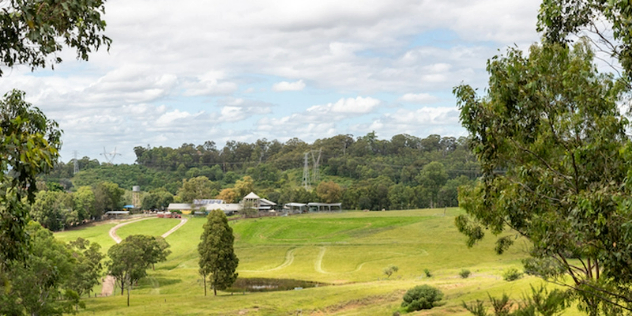
Calmsley Farm
Stretching 27km from Abbotsbury in the south to Quakers Hill in the north, this ‘corridor’ was identified as a possible open space for western Sydney residents way back in 1968, yet it was only in November 2006 that the NSW government introduced the Western Sydney Parklands Act to parliament, which set out the boundaries and established the Parklands Trust.
What makes the Western Sydney Parklands fascinating and somewhat unique is the way the bushland tracks, recreation areas and tourism facilities exist amid the furious urban development that has characterised western Sydney over the past decade. The western boundary follows the gradual curve of the M7 motorway and throughout the days we spent exploring the parklands we were continually astonished at the way pockets of natural beauty and tranquillity emerged from the hustle and bustle of industry.
Treetops Adventure
Situated at the back of the Plough and Harrow parklands in Abbotsbury, this is a ropes course strung up amongst the remnants of the Cumberland Plain woodland. Imagine the Ewok village in Return of the Jedi and you’ll have some notion of what to expect. It caters to various ages, from children as young as three right up to fit, daredevil adults. It’s a simple setup – pay your way at the hut, strap on your harness and headgear, complete some quick safety training, and away you go.
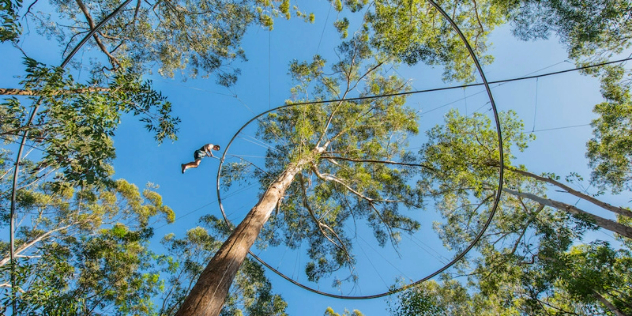
Western Sydney Treetops Adventure Park
The more advanced courses can see participants eight to 10 metres in the air, traversing tightrope wires and rickety bridges. There are around 20 flying foxes across the courses, an exhilarating reward for those daring enough. The largest is the Zipcoaster, which starts at the highest point of the grounds and corkscrews its way to the bottom like an aerial toboggan run.
First opened in 2014, the Treetops Adventure is an all-weather activity the whole family can enjoy. Although it often gets busy of a weekend and in school holidays, mid-week we more or less had the place to ourselves.
Calmsley Hill City Farm
When you’re navigating your way into Calmsley Hill City Farm you could be forgiven for thinking Siri has steered you wrong. You wind through the streets of suburban Abbotsbury before the entrance to the farm’s carpark appears up ahead as if by some prosaic magic. This property has been a farm of one sort or another since 1806. In 1984, it took on its current form under the name Fairfield City Farm, before it joined the Sydney Parklands Trust and acquired its current name in 2009.
It’s a convenient way to get suburban kids of all ages – some of whom don’t even have a backyard – acquainted with a variety of farm animals.
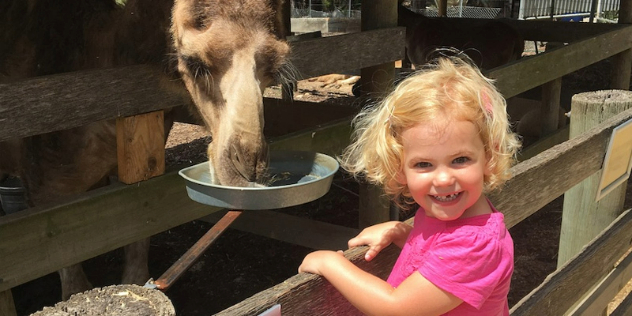
Camel being fed at Calmsley Hill.
Calmsley Hill provides stockwhip, sheep shearing and working dog shows, the opportunity to milk cows, and has an educational talk on koalas. If you buy a bag of animal food at reception, you can also hand feed the kangaroos and camels that call the farm home. When my family and I were there a few years ago, we were allowed to bottle feed the baby goats. Younger children absolutely love the tractor ride, which zig-zags around on the farm’s hillside.
Sugarloaf Ridge
One of Western Sydney Parklands’ best assets is that no matter how you to travel – by car, bicycle or foot – you have a way to access most of its length and breadth. Main roads encircle it, while smaller roads, cycleways and footpaths (ranging from wide bitumen walkways to narrow bush tracks) squiggle through its interior.
A good way to immerse yourself in its bushier sections is to drive up Border Road to Sugarloaf Ridge. This unexpected eyrie offers spectacular views all the way to the city and on a clear day you can see the distinctive shapes of Sydney Tower and the Harbour Bridge. There are several places to eat lunch with a view, including one spot that overlooks the goings-on at Calmsley Hill Farm.
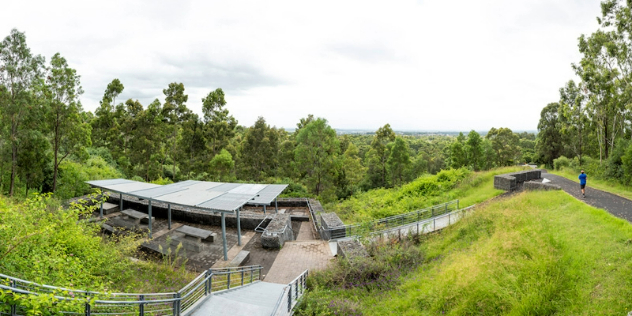
Sugarloaf Ridge
It’s also the gateway to the Sugarloaf and Moonrise Loop bushwalks through some wild scrubland that’s home to fairy wrens, wanderer butterflies and, in the warmer months, a snake or two. Some sections are hilly, so a reasonable level of fitness is required.
Ginger Meggs Memorial
Australia has neglected so much of its folk history, especially in the modern era. Did you know, for example, that Granny Smith apples are named after a real woman, Maria Ann Smith? She emigrated to Australia in 1839 and began cultivating the famous apples on her Eastwood property in the 1850s. Another example is Ginger Meggs – and not the famous comic strip character. This was a working dog who lived in western Sydney during the 1930s and his tale rivals that of the Dog on the Tuckerbox at Gundagai.
According to the plaque – which, along with the trail leading into it and the stonework around it, could use some TLC – in 1932 stockman Harrie Davis and his kelpie Ginger Meggs were droving a flock of sheep from their property in Bossley Park to the saleyards in Flemington. They were moving along the road at Auburn when a truck ploughed into the flock, killing many sheep and injuring Harrie. The drover leading the flock stayed with Harrie until help arrived.
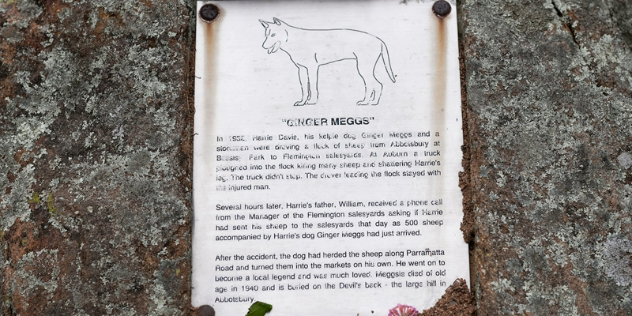
Ginger Meggs Memorial
Some hours later, Harrie’s father received a phone call from the manager of the Flemington saleyards asking if Harrie had sent his sheep for sale. It turned out that after the accident Ginger Meggs had herded the 500 head of sheep serveral kilometres along Parramatta Road and into the markets all by himself. His remarkable feat made him a local legend and he’s still remembered 82 years after his death in 1940.
Urban Farms
Sydney’s westward expansion over two centuries has followed a general pattern: bush becomes farmland, farmland becomes housing and industry. But pockets of farmland occasionally survive the urban sprawl and that’s the case at Horsley Park.
On Ferrers Road, just a stone’s throw from the industrial area and Sydney Motorsport Park, is a cluster of ‘urban farms’ – small agricultural enterprises preserved against development by dint of their location within Western Sydney Parklands.
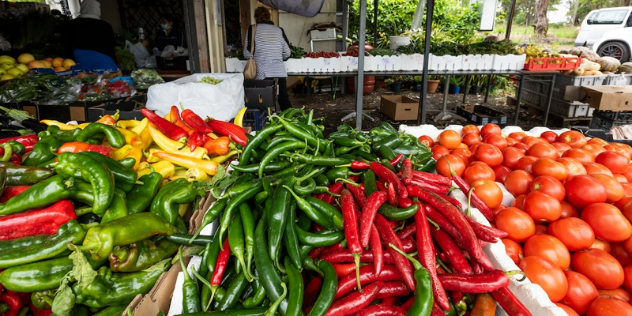
Urban Farms
In keeping with Sydney’s history, most are run by immigrants or the offspring of immigrants. Among the businesses in the area are Lam’s Farm Fresh, Sun’s Fresh Farm, Fenech Family Farm and Sydney Flowers Express. Western Sydney Parklands and Fairfield City Council envision this area expanding into a farm gate trail where visitors can walk or cycle between the properties to buy fresh produce. The nearby Lizard Log parklands also runs regular markets where all the produce is available in one spot.
George Maunder Lookout
It would be interesting to know which visionary first decided NSW’s dams should double as public recreation areas. Because drinking water must be kept free from pollutants, the area surrounding it is typically kept in a natural state that makes it ideal for parkland and picnics.
Prospect Reservoir is among the oldest dams in NSW. When completed in 1888 to ensure reliable drinking water for Sydney, it was the largest dam in Australia. Unlike many other dams, its history is recorded in a series of signs and plaques at various points of interest. While Warragamba Dam superseded it as Sydney’s main water supply in 1960, it remains in service, bulging out on the eastern side of the Western Sydney Parklands perimeter. There’s road access to the top of the steep hill above it, upon which is situated George Maunder Lookout.
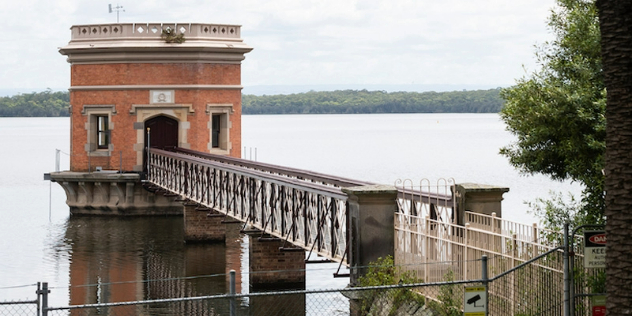
Prospect Reservoir
This provides a spectacular view of the reservoir and the surrounding landscape, including the silhouetted humps of the Blue Mountains on the horizon. Shaded picnic tables are plentiful and the park area has decent toilet facilities. While you’re there you’d never believe the Prospect Highway was only a few hundred metres away as the crow flies.
During our visit, wild kangaroos bounded past the chain-link fence near the entrance to the dam.
Sydney Zoo
Given it can take western Sydney residents up to two hours to travel to Sydney’s famous Taronga Zoo, having a second zoo in a more convenient location made sense. Situated only a short drive from the centre of Blacktown in Sydney’s north-west, Sydney Zoo opened in 2019 and became an immediate hit.
Proximity to one of Sydney’s fastest-growing populations is not the only reason for its success. In addition to all the animals one expects from a world-class zoo – lions, elephants, meerkats, primates and an assortment of Australian native species – Sydney Zoo boasts a few things this seasoned zoo veteran has never seen before, including an aquarium that’s home to bull sharks. Perhaps even more remarkable, the food and coffee at the Boulevard Eatery are genuinely good. It’s one of three eateries at the zoo. The other two – the Lion Deck Café and Tiger Pool Café – open on busier days and, as their names suggest, overlook the lion and tiger enclosures.
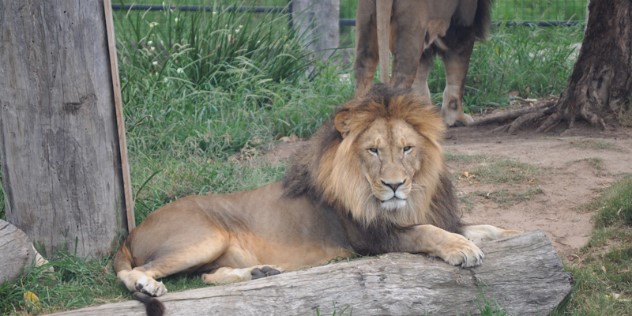
Lions at Sydney Zoo.
This is also the only zoo of my acquaintance that has a Ferris wheel. From the top, visitors get a bird’s-eye view of the entire park and the surrounding area, including nearby Bungarribee Park – yet another place where western Sydney residents can enjoy a picnic and walks through greenery.
My personal highlight from this zoo was the nocturnal house, which is home to everything from sugar gliders to death adders, followed by the see-through saltwater crocodile enclosure. On our visit, the five-metre inhabitant had his snout pressed up against the window, putting his fearsome teeth on full display.
Chang Lai Yuan Gardens
Blacktown isn’t the first city that comes to mind when you think of culture, but just a short stroll from Doonside train station are these picturesque Chinese gardens. A co-operative project between Blacktown Council and its counterpart in Liaocheng, China, these gardens were first opened to the public in 2012 and were designed and constructed as a symbolic gesture of friendship between the two cities.
Occupying a large area of Nurragingy Reserve in the northern reaches of Western Sydney Parklands, the centrepiece is a waterfall that cascades down into a lake, while the pagoda archway over the entrance to the park and the reflection pool above the waterfall are impressive examples of intricate Chinese architecture. It’s a peaceful place to take a walk or sit and enjoy a picnic lunch, while shutterbugs will be in their element capturing the gardens’ different aspects.
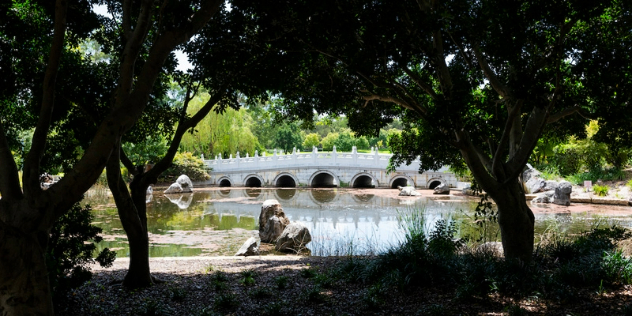
Chang Lai Yuan Gardens
The nearby Wren picnic area is also worth checking out, especially if you have kids in tow. There are plenty of shade trees and it has a free water park – a big hit during summer.
Find your way
Perhaps the best thing about Western Sydney Parklands is that everything is packed into a comparatively small area, so it’s only a quick walk or drive to the next attraction once you’re there.
The Western Sydney Parklands website westernsydneyparklands.com.au has everything you could possibly need, including lists of things to do and detailed maps.
Alternatively, you can contact the Parklands Trust during business hours on (02) 9895 7500.


